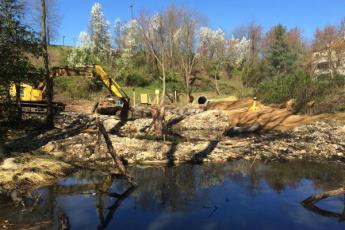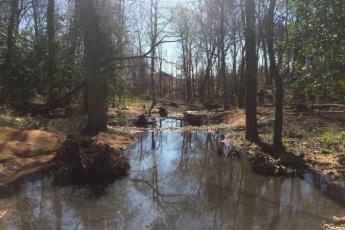Research ProjectMuddy Creek Restoration
Stream Restoration Science
Affiliated Labs
Description
Streams provide important habitats and can improve water quality. But these ecosystem services can be disrupted in urbanized watersheds, where impervious surfaces accelerate runoff causing erosion of stream channels. Deeply eroded stream channels flush more sediment downstream and displace animals that live in those streams. Streams that are deeply eroded are also less able to flood over their banks. Overbank flooding is important to stream health, because it slows down water flow and allows floodplains to remove sediments and plant nutrients from the water, improving the health of lakes and coastal waters downstream.
Within Maryland, a restoration approach known as Regenerative Stormwater Conveyance (RSC) has gained much popularity. While traditional restorations stabilize stream banks, RSC systems seek to increase channel residence time and enhance floodplain connections during higher flows. RSCs also seek to improve the biological functions of eroded streams by promoting denitrification, sediment deposition, and nutrient assimilation into stream biota. The RSC method fills eroded channels with gravel, sand, and organic matter, and recreates pool and riffle habitats using a series of rock weirs. However, the ability of RSCs to remove nutrients and sediments is variable, particularly in urban watersheds during storm flows.
To investigate the factors impacting the effectiveness of RSCs, we are conducing experiments at two streams recently restored using RSCs. The first is at Muddy Creek, a deeply eroded stream in SERC's forests in Edgewater, Md., which had an RSC system installed in January 2016. The second is at a stream beside a highly urbanized location in Annapolis. To perform a robust assessment of the restoration's effectiveness, we are using 40 years of baseline water quality data within two small watersheds, as well as recent Maryland Biological Stream Survey Monitoring monitoring. We have also installed riparian and channel wells, piezometers, intensive chemical water quality monitoring, and vegetation plots.
How the Regenerative Stormwater Conveyance Works:
- Creates riffles, pools, and meanders to slow down the water and create habitats.
- Raises the stream by partly filling the channel.
- Lowers the floodplain by excavation
Goals of stream restoration:
- Reduce the erosive power of storm water.
- Reconnect the stream and the floodplain.
- Remove nitrogen, phosphorus, and suspended sediment from stream water.
- Improve habitats for desirable plants and animals.
Off-Campus Restoration Experiment: Harbor Center









